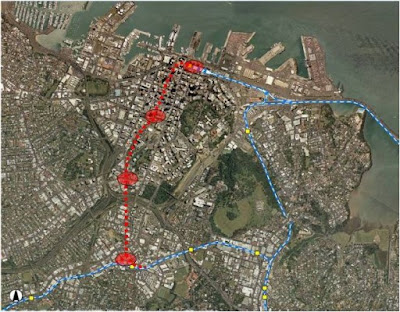Leipzig City Rail Tunnel, Germany
 |
| Leipzig old terminus transport network image cred: Net Resources International. |
Leipzig is located at Sachsen of Germany. It has a population of 510,000 in 2007. The total length of the railway line to be built is 5.3km, with the establishment of five new stations. The project of a rail tunnel is set for transforming its transport links in both the urban area and south-east Germany as a whole (Net Resources International, 2011).The new built rail tunnel will also replace the current Leipzig’s terminus system for generating more efficient outcome for its urban and local transport services.
As with many urban-based rail projects, the city tunnel scheme aims to encourage public transport use, the projection being to save an equivalent number of 320,000km by car each day. As results of it, more jobs can be created for the local community. Particular techniques are incorporated in this project for the purpose of preservation of historical buildings and reduce its noise levels. In terms of services, a cross-mode ticketing will apply with other transport services covering regional trains, buses and trams.
 |
| the new rail tunnel project underway Image Cred: Net Resources International. |
 |
| new railway system Photo Cred: Net Resources International. |
Japan: Seikan Submarine Tunnel
The Seikan Submarine Tunnel in Japan is regarded as the longest Railway Tunnel which is constructed beneath a Seabed.
 |
| Japan Seikan Rail Photo Cred: Japan Atlas Architecture |
 |
| indication of the submarine construction Image Cred: Architectual Guidance |
To get a real experience of travelling inside the tunnel, the video below is provided:
Swiss Tunnel- to breakthrough with the world’s longest rail tunnel
The project currently under construction in Swiss is to be built the world’s longest tunnel of 57km that aims at cutting journey times and solve congestion problems on the road. The tunnel will enable trains to travel from Basel in the north to South of the country in just two hours. There are around 2,500 workers occupied in this project and it is to be finished in 2017.
The funding of the tunnel’s construction is sought from the local communities, complaints have been wide-cross for its high cost, and this is regarded as one of the biggest risk for this project.
 |
| the Swiss Tunnel currently under construction Photo Cred: Guardian News and Media |
Furthermore in addition, there are other rail tunnel projects are currently underway. Such as the Melbourne Metro Rail Tunnel in Australia. Animation of this project is provided at the link: http://www.transport.vic.gov.au/web23/Home.nsf/AllDocs/C8E007130C138F60CA2577EA0005C39B?OpenDocument, which is quite attractive to me.
Reference:
Davies, L. (2010) Swiss to breakthrough with world’s longest rail tunnel, http://www.guardian.co.uk/world/2010/oct/15/gotthard-base-tunnel-switzerland, (accessed: 27/April/2011).
Japan Atlas Architecture. (2010) Seikan Submarine Tunnel,
http://web-japan.org/atlas/architecture/arc02.html, (accessedL 24/april/2011).
Japan Atlas Architecture. (2010) Seikan Submarine Tunnel,
http://web-japan.org/atlas/architecture/arc02.html, (accessedL 24/april/2011).
Net Resources International, (2011) Leipzig City Tunnel, Germany,
http://www.railway-technology.com/projects/leipzig_tunnel/, (accessed: 27/April/2011).







